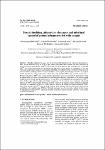Faecal shedding, alimentary clearance and intestinal spread of prions in hamsters fed with scrapie
Krüger, Dominique
Thomzig, Achim
Lenz, Gudrun
Kampf, Kristin
McBride, Patricia
Beekes, Michael
Shedding of prions via faeces may be involved in the transmission of contagious prion diseases. Here, we fed hamsters 10mg of 263K scrapie brain homogenate and examined the faecal excretion of disease-associated prion protein (PrPTSE) during the course of infection. The intestinal fate of ingested PrPTSE was further investigated by monitoring the deposition of the protein in components of the gut wall using immunohistochemistry and paraffin-embedded tissue (PET) blotting. Western blotting of faecal extracts showed shedding of PrPTSE in the excrement at 24–72 h post infection (hpi), but not at 0–24 hpi or at later preclinical or clinical time points. About 5% of the ingested PrPTSE were excreted via the faeces. However, the bulk of PrPTSE was cleared from the alimentary canal, most probably by degradation, while an indiscernible proportion of the inoculum triggered intestinal infection. Components of the gut-associated lymphoid tissue (GALT) and the enteric nervous system (ENS) showed progressing accumulation of PrPTSE from 30 days post infection (dpi) and 60 dpi, respectively. At the clinical stage of disease, substantial deposits of PrPTSE were found in the GALT in close vicinity to the intestinal lumen. Despite an apparent possibility of shedding from Peyer’s patches that may involve the follicle-associated epithelium (FAE), only small amounts of PrPTSE were detected in faeces from clinically infected animals by serial protein misfolding cyclic amplification (sPMCA). Although excrement may thus provide a vehicle for the release of endogenously formed PrPTSE, intestinal clearance mechanisms seem to partially counteract such a mode of prion dissemination.
No license information

